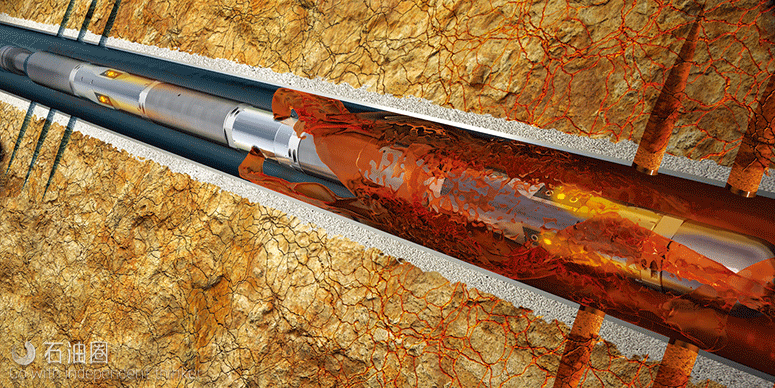ACTive Q service couples real-time fiber-optic telemetry and thermal transfer flow measurements for onsite matrix treatment evaluation and real-time treatment diagnostics in just one run in the well. The service enables operators to evaluate the flow rate contribution to each interval, assess the zonal coverage achieved during the treatment, and decide whether to further adjust the stimulation schedule to optimize the treatment outcome.
Achieve greater success during well interventions
The versatile ACTive Q service provides high-quality downhole flow monitoring data and is complemented by the robust ACTive DFLO CT real-time flow measurement tool. These measurements facilitate decision making and improve the effectiveness of treatment placement by providing operators with highly accurate information.
ACTive DFLO CT real-time flow measurement tool
As part of the ACTive Q* CT real-time flow measurement service, the ACTive DFLO* CT real-time flow measurement tool provides downhole fluid velocity measurement and direction detection in real time while maintaining pump through capability.
ACTive Q service acquires high-quality flow data using the ACTive DFLO CT real-time flow measurement tool, which comprises two sensor arrays that monitor the fluid’s velocity as it travels around the tool.
The measurements are conveyed to surface on CT with real-time fiber optic telemetry. Effective in a wide range of downhole environments, the ACTive DFLO tool provides additional feedback on the effectiveness of the intervention. In particular, the tool helps track the direction that the fluid takes due to the reservoir’s response to the treatment. Intervention parameters such as pumping rates, injection depth, and fluid volumes can be adjusted with increased confidence, because they are based on the real-time downhole information provided by the ACTive DFLO tool and input into the Techlog* wellbore software platform.
Combining ACTive DFLO tool readings with other ACTive services measurements—such as pressure, temperature, gamma ray, casing collar location, tension compression, or DTS—enhances the effectiveness of real-time CT services. The combined monitoring of those critical downhole and distributed parameters improves the understanding of the treatment as it progresses, and in turn, increases the effectiveness of ACTive services.
As an alternative to complex interventions that include production logging tools for simple post job evaluation profiles, or profiling before and after a specific treatment, the ACTive DFLO tool can also profile flows across a producing or injecting interval to better inform decisions on treatment options.
APPLICATIONS
■ Fluid injection profiling
■ Fluid placement control
■ Leak detection
■ Treatment effectiveness monitoring
■ Diversion confirmation
BENEFITS
■ Enables accurate, efficient fluid placement by providing downhole flow monitoring data in real time
■ Evaluates treatment effectiveness quickly, so adjustments can be made without delay
■ Reduces operational time by enabling a wide range of CT services to be used in the same run
FEATURES
■ Real-time fluid direction detection and flow velocity measurement
■ Robust design with:
● high compressive load
● no centralizers or arms
● no spinners or protruding elements
● resistance to H2S, solvent, and acid
● flow-through capability
● ball-drop compatibility
■ Modular design for different configurations
■ Full compatibility with ACTive* real-time downhole coiled tubing services
■ Accurate depth control with integral casing collar locator
■ Optional gamma ray measurements
■ Pressure and temperature sensors to monitor treatment
■ Fast-rate telemetry
■ Compatibility with distributed temperature sensing (DTS)
CASE STUDY
ACTive Q Service Helps Operator Improve Wells’ Injectivity Index Nearly 300%
Innovative real-time CT flow measurement technology enables unprecedented control and optimization of dual injection stimulation in horizontal openhole injection wells
Optimize stimulation operation after ineffective bullheading
Bullheading stimulation fluids into two long horizontal openhole water injection wells in Central America left much of the reservoir untouched. There was little available information about the permeability, porosity, or fracture distributions of the formation to prepare a thorough design analysis, and the remote location of the site further complicated matters. To optimally acidize the dolomitic carbonate formation, the operator needed high-quality, real-time flow data to assess the true fluid intake along the horizontal interval, and to monitor and adjust the treatment while it was still in progress.
Target the stimulation using real-time CT flow measurement technology
Schlumberger suggested ACTive* real-time downhole coiled tubing services to acquire the real-time downhole data needed to optimize the acid treatment. First, ACTive Profiling* CT real-time distributed temperature sensing and production logging services and ACTive Q* CT real-time downhole flow measurement service were used to evaluate the initial zonal coverage along the openhole interval while water was bullheaded at the nominal surface pump rate and injection pressure.
DTS and flow monitoring data after stimulation indicate improved zonal coverage of the water injection at the same nominal surface injection pressure.
Based on the initial profile results and a falloff test, the stimulation strategy was revised to target different intervals, introduce the use of dual injection for a deeper reach along the interval, and adjust pumping rates and volumes. ACTive Q service was used during the dual injection process to ensure that the stimulation fluid pumped through the CT was being forced into the right section of the wellbore, as opposed to flowing back to shallower thief zones as it had during simple CT spotting. As part of the ACTive Q service, the ACTive DFLO tool measured the fluid velocity and detected flow direction during the stimulation job. Throughout the process, communication and remote decision making were facilitated by InterACT* global connectivity, collaboration, and information service.
Injectivity increased nearly 300%
After the treatment, ACTive Profiling and ACTive Q services were again used to assess the results of the stimulation, and a new falloff test was performed. The results of those studies showed improved zonal coverage of the injection water (at equal surface injection pressure) and deeper reach along the horizontal sections. A reduced skin value indicated that formation damage had been effectively bypassed. Most importantly, the injectivity index of both wells improved almost 300% following treatment.
ACTive Q Service Key to Improving Injection Rate of Dual-Lateral Power Injector by 600%
ACTive DFLO tool and Discovery MLT system efficiently confirm lateral entry and accurate placement of treatment fluid to deliver outstanding stimulation results
Operator needs to improve declining injection rate in dual-lateral injector well
A Middle East operator had drilled and completed a dual-lateral water injector well to provide pressure support and enhance reservoir sweep efficiency. The well had two openhole laterals of more than4,000 ft [1,219 m] each. Initial injection rates were 5,000 bbl/d with 2,800 psi [19 MPa] of wellhead pressure, but injection gradually declined to 2,000 bbl/d (maintaining the same injection pressure).The operator decided to acidize the two laterals with the aim of restoring the well to its initial injection rate of 5,000 bbl/d.
Original combination of technologies provides unprecedented guidance for advanced stimulation strategy
Schlumberger recommended performing the treatment using the Discovery MLT system to locate the entrance of each lateral. Once accessed, each lateral was immediately identified using the ACTive GR tool by comparing real-time data with the operator’s reference logs. To optimize stimulation fluid placement, the operator needed accurate data about the injection contribution to each lateral as well as the distribution of intake and tight zones along both openhole sections. To this end, the ACTive DFLO* CT real-time flow measurement tool was used to profile flow along the entire sections of interest.
Once it was determined that most of the injected water was flowing to the main bore, Schlumberger engineers worked with the operator to adjust the pumping sequence along each lateral and maximize acid coverage to obtain a more uniform intake.
Results far exceed target injection rate
The comparison between the pre- and post stimulation ACTive Q service profiles showed a significant improvement in coverage along the two laterals and a more balanced injection distribution between them. As a result of this intervention, the well’s injection rate increased to14,000 bbl/d, an impressive 600% improvement over the pre stimulation level. These results also substantially exceeded the target injection rate of 5,000 bbl/d.



 石油圈
石油圈
